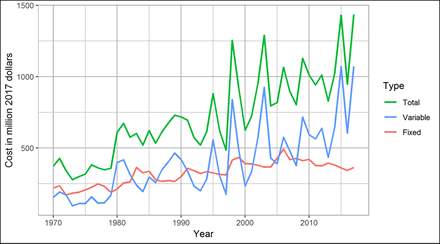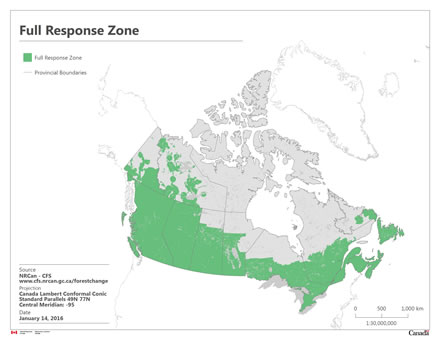To protect Canadians, private residences, businesses, wood supply and critical infrastructure, Canadian wildland fire management agencies invested between $800 million to $1.4 billion annually over the last 10 years.
The cost of wildland fire protection can be measured through wildland fire management expenditures, which may include fire preparedness, mitigation, response and recovery costs. We use the cost of wildland fire suppression as an indicator of the cost of all wildland fire management expenditures.
Future projections suggest that the cost of wildland fire protection will continue to increase rapidly, particularly in western Canada.
- Why the cost of fire protection is important
- What has changed
- The outlook
- Adaptation tools and resources
Read how indicators of the cost of fire protection are defined
Why tracking the cost of fire protection is important
Provincial and territorial fire management agencies attempt to reduce the damage caused by wildland fire to forest-dependent communities, critical infrastructure, wood supply and other resources. These efforts require significant investments.
Agencies plan budgets based on average wildland fire suppression costs over a period of several years. However, wildland fire activity. and severity varies considerably from year to year, making it difficult to anticipate future costs. To help identify long-term trends, the Canadian Forest Service systematically tracks wildland fire suppression costs (Figure 1).
What has changed
The annual national cost of wildland fire protection exceeded $1 billion (Figure 1) for six of the last 10 years. On average, costs have risen about $150 million per decade since data collection started in 1970. This cost increase relates to real increases in suppression costs and not the fixed costs to maintain firefighting personnel and program management.
The most expensive years have been those with high wildland fire activity and severity in inhabited forest areas. Many provincial wildfire management agencies respond differently when wildland fires are not putting communities or assets at risk. Therefore, in a year where there are large fires outside of the area where all fires are actively suppressed, a high annual area burned may not correspond to a high cost of fire protection (Figure 2).

Figure 1 – The cost of wildland fire protection in Canada from 1970 to 2017 (in million 2017 Canadian dollars)
Larger image [45 Kb]

Figure 2 – Canada’s Full Response Zone, in which all wildland fires are actively suppressed
Larger image [84 Kb]
Graph data
| Year | Fixed fire expenditures (x1,000,000) in 2017$ | Variable fire expenditures (x1,000,000) in 2017$ | Total fire expenditures (x1,000,000) in 2017$ |
|---|---|---|---|
| 1970 | 191.99 | 134.90 | 326.90 |
| 1971 | 205.98 | 167.98 | 373.96 |
| 1972 | 150.03 | 149.69 | 299.72 |
| 1973 | 160.11 | 82.86 | 242.97 |
| 1974 | 166.44 | 96.21 | 262.65 |
| 1975 | 181.06 | 96.23 | 277.29 |
| 1976 | 196.72 | 138.77 | 335.49 |
| 1977 | 217.21 | 98.57 | 315.79 |
| 1978 | 202.45 | 101.72 | 304.17 |
| 1979 | 164.78 | 147.90 | 312.68 |
| 1980 | 186.03 | 348.74 | 534.76 |
| 1981 | 223.62 | 365.96 | 589.58 |
| 1982 | 229.28 | 275.51 | 504.79 |
| 1983 | 317.81 | 210.18 | 527.99 |
| 1984 | 285.33 | 170.98 | 456.31 |
| 1985 | 295.78 | 260.26 | 622.21 |
| 1986 | 242.45 | 225.43 | 467.88 |
| 1987 | 232.50 | 304.99 | 537.50 |
| 1988 | 238.45 | 353.55 | 592.00 |
| 1989 | 232.52 | 407.55 | 640.07 |
| 1990 | 261.91 | 367.15 | 629.06 |
| 1991 | 313.56 | 296.08 | 609.63 |
| 1992 | 299.03 | 203.15 | 502.19 |
| 1993 | 280.82 | 175.24 | 456.06 |
| 1994 | 292.51 | 246.35 | 538.87 |
| 1995 | 285.47 | 487.35 | 772.82 |
| 1996 | 276.59 | 268.45 | 621.27 |
| 1997 | 272.44 | 153.20 | 425.65 |
| 1998 | 364.80 | 734.95 | 1099.75 |
| 1999 | 381.12 | 428.83 | 809.95 |
| 2000 | 343.02 | 204.74 | 547.76 |
| 2001 | 339.87 | 293.12 | 632.99 |
| 2002 | 331.92 | 506.32 | 838.24 |
| 2003 | 320.31 | 810.06 | 1130.38 |
| 2004 | 320.29 | 376.54 | 696.82 |
| 2005 | 376.32 | 341.42 | 717.74 |
| 2006 | 430.97 | 504.02 | 934.99 |
| 2007 | 366.21 | 420.74 | 786.95 |
| 2008 | 374.74 | 329.56 | 704.30 |
| 2009 | 360.53 | 628.32 | 988.85 |
| 2010 | 419.29 | 592.25 | 1011.54 |
| 2011 | 378.06 | 563.96 | 942.01 |
| 2012 | 374.55 | 637.08 | 1011.63 |
| 2013 | 393.66 | 434.70 | 828.36 |
| 2014 | 379.64 | 643.49 | 1023.13 |
| 2015 | 359.99 | 1069.95 | 1429.94 |
| 2016 | 342.72 | 604.85 | 947.57 |
| 2017 | 362.71 | 1072.45 | 1435.16 |
The outlook
Researchers at the Canadian Forest Service have developed models that aim to project future costs of wildland fire protection across Canada. As climate change is causing weather conditions that are more conducive to wildland fire, expenditures are projected to increase rapidly, particularly western Canada.
A better understanding of current and future vulnerable forest areas will allow wildfire management agencies to prepare and respond to wildland fires. It also helps to reduce the risk of wildfire to communities and critical infrastructure by informing investments in wildfire prevention and mitigation measures.
How the cost of fire protection indicators is defined
Information about the cost of wildland fire protection is compiled by provincial and territorial government agencies and by Parks Canada for Canada’s national park lands. This information is summarized by the Canadian Interagency Forest Fire Centre.
The cost of fire protection can be measured through wildland fire management expenditures, which may include fire preparedness, mitigation and response. In addition to the cost of fire protection, there are the damage costs of fire which include insured and uninsured property losses, business interruptions, and recovery and rebuilding.
Wildland fire protection costs are estimated as a function of future area burned, which is modelled as a function of the climate moisture index (CMI). Estimates of future area burned are generated from projections of the CMI under two climate change scenarios for four different climate models (called General Circulation Models).
Wildland fire management expenditure data has been summarized from each wildland fire management agency across Canada for nearly 50 years. Expenditures are calculated by the Canadian consumer price index, as reported by Statistics Canada.
Annual statistics on these measures can be obtained from the National Forestry Database.
Future projections of wildland fire protection costs in Canada have been developed by researchers at the Canadian Forest Service.
- Wildland fire management: Expenditures are broken down into fixed and variable costs. Fixed costs are associated with maintaining the wildland fire management program and reflect the typical fire load. Variable costs reflect the cost of additional fire fighters and aircraft required during a challenging wildland fire season.
- Zonation: Expenditures vary across the country and within provinces and territories, depending on land management objectives, forest resources and other values at risk. Most provinces and both forested territories (Yukon and Northwest Territories) divide their forested areas into two zones: a full response zone, where all fires receive active suppression (Figure 2), and a modified response zone, where most fires are left to burn naturally.
Sources and references for the cost of fire protection and its indicators
- Canadian Council of Forest Ministers. 2005. Canadian wildland fire strategy declaration. [1.6 Mb PDF]
- Canadian Wildland Fire Strategy Assistant Deputy Ministers Task Group. 2005. Canadian wildland fire strategy: A vision for an innovative and integrated approach to managing the risks. (Catalogue no. Fo134-1/2005E-PDF). Edmonton, AB: Canadian Council of Forest Ministers. [2.5 Mb PDF]
- Flannigan, M., Stocks, B., et al. 2009. Impacts of climate change on fire activity and fire management in the circumboreal forest. Global Change Biology 15, 549–560.
- Magnussen, S., and Taylor, S.W. 2012. Inter- and intra- annual profiles of fire regimes in the managed forests of Canada and implications for resource sharing. International Journal of Wildland Fire 21, 328–341.
- National Forestry Database. Forest fires – National tables.
- Podur, J., and Wotton, M. 2010. Will climate change overwhelm fire management capacity? Ecological Modelling 221, 1301–1309.
- Statistics Canada. CANSIM table CANSIM table 326-0021: Consumer price index.
- Stocks, B.J., Mason, J.A., et al. 2002. Large forest fires in Canada, 1959–1997. Journal of Geophysical Research 107, FFR 5-1–FFR 5-12.
- Stocks, B.J. 2014. Evaluating past, current and future wildland fire load trends in Canada (Report to the Wildland Fire Management Working Group of the Canadian Council of Forest Ministers). [33.7 Mb PDF]
- Wotton, B.M., and Stocks, B.J. 2006. Fire management in Canada: Vulnerability and risk trends. In Hirsch K.G., and Fuglem, P. (eds.), Canadian wildland fire strategy: Background synthesis, analysis, and perspectives, 49–55. Edmonton, AB: Canadian Council of Forest Ministers. [2.5 Mb PDF]
Canadian Forest Service key contacts
Mike Wotton, Research Scientist, Forest Fire, Great Lakes Forestry Centre
Sylvie Gauthier, Research Scientist, Forest Succession, Laurentian Forestry Centre
Emily Hope, Research Scientist, Forest Resource Economics, Great Lakes Forestry Centre
Nirmal Subedi, Wildfire Research Economist, Pacific Forestry Centre
Brian Stocks, Research Scientists (Emeritus), Forest Fire Management, Great Lakes Forestry Centre
David Martell, Professor (Emeritus) in Forest Fire Management, University of Toronto
Adaptation tools and resources
Fire Smart Canada – helps people understand the potential of wildland fire affecting homes and communities. It includes a risk reduction program for forestry companies.
Forest Change Toolkit – a list of tools and resources for climate change adaptation
- Boulanger, Y., Gauthier, S., et al. 2013. Fire regime zonation under current and future climate over eastern Canada. Ecological Applications 23, 904–923.
- Canadian Council of Forest Ministers. 2005. Canadian wildland fire strategy declaration [1.6 Mb PDF].
- Canadian Wildland Fire Strategy Assistant Deputy Ministers Task Group. 2005. Canadian wildland fire strategy: A vision for an innovative and integrated approach to managing the risks. (Catalogue no. Fo134-1/2005E-PDF). Edmonton, AB: Canadian Council of Forest Ministers. [2.5 Mb PDF]
- Flannigan, M., Stocks, B., et al. 2009. Impacts of climate change on fire activity and fire management in the circumboreal forest. Global Change Biology 15, 549–560.
- Gauthier, S., Raulier, F., et al. 2015. Strategic analysis of forest vulnerability to risk related to fire: An example from the coniferous boreal forest of Quebec. Canadian Journal of Forest Research 45, 553–565.
- Gauthier, S., Vaillancourt, M.A., et al (eds.). 2009. Ecosystem management in the boreal forest. Québec, Qc: Presses de l’Université du Québec.
- Hope, E. S., McKenney, D. W., Pedlar, J. H., Stocks, B. J., and Gauthier, S. 2016. Wildfire suppression costs for Canada under a changing climate. PloS one 11, e0157425.
- Magnussen, S., and Taylor, S.W. 2012. Inter- and intra- annual profiles of fire regimes in the managed forests of Canada and implications for resource sharing. International Journal of Wildland Fire 21, 328–341. [2.5 Mb PDF]
- Podur, J., and Wotton, M. 2010. Will climate change overwhelm fire management capacity? Ecological Modelling 221, 1301–1309.
- Stocks, B.J. 2014. Evaluating past, current and future wildland fire load trends in Canada. Sault Ste. Marie, ON: BJ Stocks Wildfire Investigations. [33.7 Mb PDF]
- Stocks, B. J., and Martell, D. L. 2016. Forest fire management expenditures in Canada: 1970–2013. The Forestry Chronicle 92, 298-306.
- Stocks, B.J., Mason, J.A., et al. 2002. Large forest fires in Canada, 1959–1997. Journal of Geophysical Research 107, FFR 5-1–FFR 5-12.
- Wotton, B.M., and Stocks, B.J. 2006. Fire management in Canada: Vulnerability and risk trends. In Hirsch K.G., and Fuglem, P. (eds.), Canadian wildland fire strategy: Background synthesis, analysis, and perspectives, 49–55. Edmonton, AB: Canadian Council of Forest Ministers.